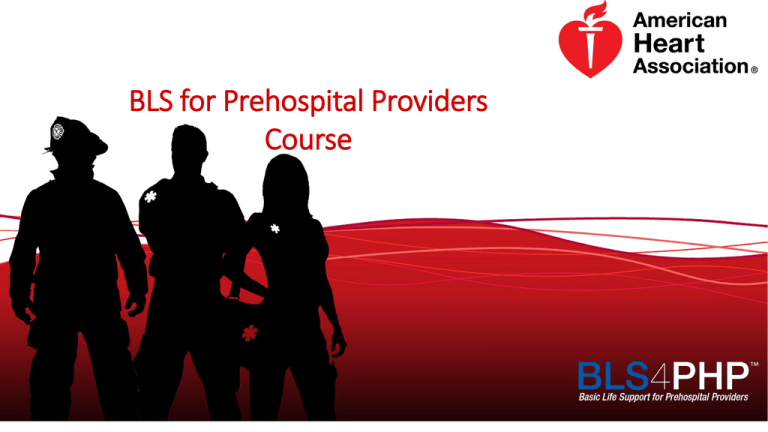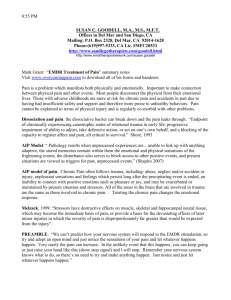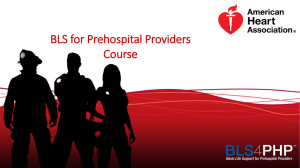BLS PHP_faculty workshop_short version_091814_DOMESTIC
advertisement

BLS for Prehospital Providers Course BLS PHP Workshop Objectives • Discuss how historical feedback from the EMS community shaped the development of the course • Describe the new format: “flipping the classroom” • Describe the most critical roles of the resuscitation team, and secondary roles as responders increase: the “pit crew approach” • Identify the importance of chest compression fraction (CCF) for survival rates • Demonstrate the high-performance teams concept • Identify procedure for how Training Centers and Instructors administer course keys to students 2 Overview History and Purpose of New BLS Course Specific EMS Scenarios EMS Field Application Local Protocols HighQuality CPR Why BLS PHP? In 2012, the AHA assembled an EMS Advisory Panel consisting of field providers from around the country. That group made the following recommendations: • Design a specific BLS curriculum for prehospital providers that includes EMS-specific tests • Make the scenarios entirely EMS oriented and realistic to the prehospital environment • Include high-performance teams concept to increase the level of competence • Create a curriculum that teaches how to set up the scene for high-quality CPR Course Flexibility: Flipping the Classroom • BLS PHP is a new customizable learning experience, combining online and classroom-based training into one high-performance program created specifically for prehospital professionals. • The course is the first of its kind (hybrid) for the AHA. • The total experience combines what is learned and verified in the online portion with the implementation strategies practiced in the classroom. BLS PHP Course―An Inside Look Course Strategies to Increase Survival Rates • Use the pit crew approach to teach how to conduct a code with teams varying from 2 to 6 people • Introduce BLS Instructors to the concept of structured and supported debriefing • Create scenario-based training that may represent a student’s next call in the field • Develop core course segments that provide the opportunity for medical directors to tailor the course to local response protocols BLS PHP Course Components: Online Portion Interactive Online Content • Same course objectives as BLS HCP • Written exam with the same foundational learning objectives but with prehospital terminology. • See the Science buttons so students can drill deeper into the Why? Scenario-Based Training • EMS-oriented scenarios and realistic settings for the prehospital environment • Termination of resuscitative efforts • Drowning • Pit crew approach EMS-Themed Training • Medical cause of victim driving off the road • Moving patient for better access and improved resuscitation • Practice like you play BLS PHP Course Components: Classroom Portion Customization Components Role of Ventilation Medical vs Trauma Interagency Roles Local Protocols Termination Criteria Use of AED Compression Protocols Pit Crew Local Protocols AHA guidelines: • Resource • Provide guidance • Lend supportive information • Substantiate―they are based upon available science • Many agencies use AHA guidelines to devise local treatment protocols • Protocols and guidelines not always parallel 14 BLS Debriefing •Peer to peer •Nonthreatening •Helps individuals and teams reflect on and improve performance 15 Pit Crew Approach―Instructor • Capturing and optimizing the percentage of arrest time that high-quality chest compressions are performed has a predictable improvement in survival. • The term chest compression fraction, or CCF, is just that―trying to achieve the 80% threshold, which increases survival by 200% to 300%. 16 Team Dynamics Suggested roles for a 6-member team: 1. Compressor: Does 5 cycles of chest compressions 2. Airway: Opens the airway; provides bag-mask ventilation (and uses airway adjuncts as appropriate) 3. Monitor/Defibrillator: Brings and operates an AED (ACLS and PALS providers bring a manual monitor/defibrillator); may alternate with Compressor every 5 cycles. If a monitor is present, it should be placed in a position where it can be seen by everyone 4. Team Leader: Assigns roles and makes treatment decisions; provides feedback (when needed) to the rest of the team 5. Observer/Recorder: Records the time of interventions (and frequency and duration of interruptions in compressions); communicates these to the Team Leader 6. IV/IO/Medications (ACLS provider role): Initiates IV/IO access; administers medications 17 High-Performance Team Activity Questions for Discussion: Team Performance • How could you improve the actions of the teams you observed (for the cardiac arrest in vehicle, child drowning, and cardiac arrest in bathroom scenarios)? • Do your teams do anything different from what you observed in the scenarios that you think improves patient outcomes? • Are there observational or clinical data you could share to help improve team performance? • Would you like clarification on any actions or components of the video? BLS PHP Course: New Materials Availability and Distribution New Course Materials Instructor Supplement: • Contains the tools needed to teach the classroom portion • Includes agenda, outlines, and Lesson Plans • Use with the BLS for Healthcare Provider Instructor Manual 22 Instructor Package • Instructor Supplement and CD • Classroom DVD 23 New Course Materials Lesson Plans: • New concept • Response to Training Network feedback 24 25 Other BLS PHP Resources on the Instructor Network • Equipment List • Team Diagram • Questions for Discussion • FAQ • Course Requirements Training Memo 26 Post-Workshop Evaluation Please use this link to complete a short survey on the workshop you have attended: https://www.surveymonkey.com/s/Y3PGFPH 27











